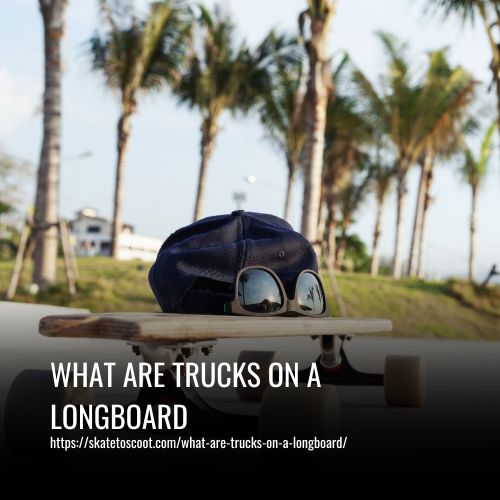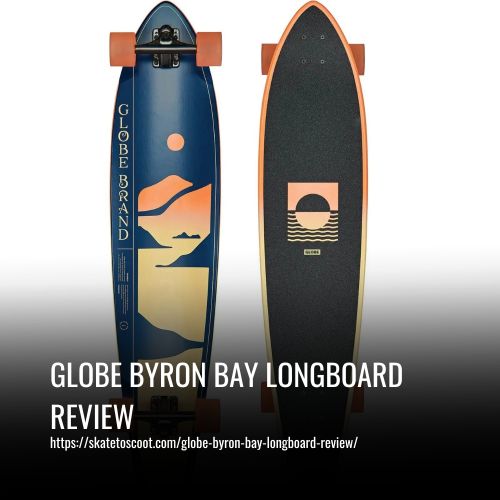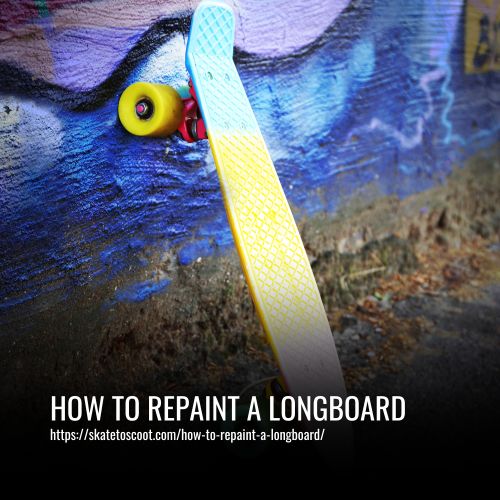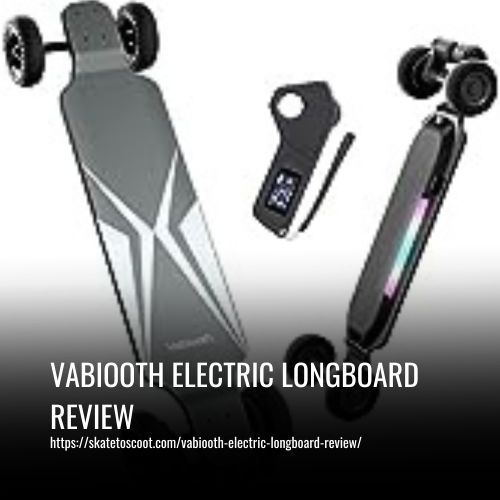As an Amazon Associate we earn from qualifying purchases.
Trucks on a longboard are metal T-shaped pieces that are attached to the underside of the longboard deck and connect to the wheels. They are an essential component for building a complete skateboard. Each longboard needs two trucks, which can be measured by hanger width or axle width.

Choosing the Right Longboard Skateboard Trucks
Choosing the right longboard skateboard trucks is crucial for a smooth and stable ride. Unlike standard skateboard trucks, longboard trucks are specifically designed to fit the larger decks and accommodate larger wheels.
Longboard trucks come in various sizes, which can be measured by hanger width or axle width. It is important to choose the right size that matches your longboard deck to ensure a proper fit. Most longboard trucks are available in either 150mm or 180mm widths.
One key feature to consider when selecting longboard trucks is the kingpin orientation. Longboard trucks often feature a “reverse kingpin” design, where the axle is placed on the opposite side of the kingpin compared to standard trucks. This configuration allows for enhanced turning and maneuverability, making it ideal for cruising and carving.
Another important factor is the bushing setup. Longboard trucks typically come with softer bushings, which allow for easier turning. However, for downhill riding or greater stability at higher speeds, stiffer bushings are recommended.
Size of Trucks:
The size of trucks on a longboard refers to the width of the hanger, which is the T-shaped piece of metal that holds the axle. Truck sizes can be a bit confusing because different brands measure them differently.
Some measure the whole axle from tip to tip, while others only measure the hanger. If a truck size is in inches, it represents the entire axle, whereas if it is measured in millimeters, it refers to just the hanger. For example, a 180 mm truck is approximately 10 inches in total size. However, it is important to note that this can vary among brands.
The size of the trucks you choose should match the width of your longboard deck to ensure a proper fit. It is always a good idea to consult the manufacturer’s specifications or the retailer for guidance when selecting the right size of trucks for your specific longboard.
Difference between Skateboard Trucks and Longboard Trucks:
Firstly, longboard trucks are wider than skateboard trucks, typically ranging from 150mm to 180mm. This wider width allows for a more stable ride, especially when cruising at higher speeds. In contrast, skateboard trucks are narrower to accommodate the smaller width of a skateboard deck.
Additionally, longboard trucks are usually reverse kingpin trucks, where the kingpin faces outward. This design creates a more responsive and maneuverable ride, perfect for carving and cruising on longboards. On the other hand, skateboard trucks often have a standard kingpin setup, with the screw facing inside to protect it from grinds and other skateboarding tricks.
The baseplate angle is also worth noting. Longboard trucks often have a lower degree baseplate angle, typically around 40-50 degrees. This lower angle provides stability at higher speeds, making them ideal for downhill riders. Skateboard trucks, on the other hand, tend to have a higher baseplate angle, usually around 50-60 degrees, allowing for more agility and quick turns.
What Size Truck Do I Need?
The size of your truck plays a crucial role in determining the stability and maneuverability of your longboard. As a general rule, your truck axles should be about as wide as your board. This means that a wider truck will provide a more stable ride, while a narrower truck allows for more effective turns.
When choosing the size of your trucks, consider the width of your longboard deck. If your front truck matches the rear axle, which is typically around 180mm or 10 inches for a Mellow setup, you’ll achieve a balanced and ideal fit. However, if your front truck is a different size, it’s not a major issue. A smaller front truck will enhance maneuverability, making it easier to make turns, while a larger front truck will increase stability for a more comfortable ride.
Keep in mind that personal preference and riding style also come into play. Some riders prefer a more stable ride for downhill racing or cruising at higher speeds, while others prioritize agile and quick turns for carving and freestyle tricks.
Features of longboard trucks:
Longboard trucks are an important component of your setup that can greatly impact your ride and overall performance. Here are some key features to consider when choosing longboard trucks:
1. Axle:
- The axle is the long pin that runs through the hanger and attaches to the wheels.
- Consider the width of your longboard deck when selecting the axle size.
- Matching the front and rear axle widths (around 180mm or 10 inches) provides a balanced fit.
2. Hanger:
- The hanger is a triangular metal piece that supports the axle.
- It plays a role in the stability and maneuverability of your ride.
- A wide hanger offers more stability, while a narrower hanger enhances maneuverability.
3. Kingpin:
- The kingpin is the bolt that holds the truck components together.
- Traditional kingpins (TKP) are commonly found on skateboards, while reverse kingpins (RKP) are more typical for longboards.
- Kingpin angle can affect the truck’s turning and responsiveness.
4. Bushings:
- Bushings are the soft urethane rings fitted around the kingpin.
- They allow the board to turn and pivot smoothly.
- The durometer (hardness) and shape of the bushings can influence your ride.
5. Riding Style and Preference:
- Consider your riding style and personal preference when choosing longboard trucks.
- Downhill riders may prioritize stability at higher speeds, while freestyle riders may prefer agility for tricks and carving.
6. Vintage Skateboards:
- If you’re riding a vintage board, check compatibility with modern longboard trucks.
- Vintage skateboards may require specific fittings that differ from modern trucks.
Truck Conversion Chart
When choosing a truck for your skateboard, it’s important to match the width of the truck to the width of your skateboard deck. To help you with this, we have created a truck conversion chart. However, please note that millimeters (mm) and inches do not convert directly because inches include the axles while mm only includes the metal hanger portion.
| Millimeters (approx.) | Inches (approx.) |
|---|---|
| 85mm | 5.9 in |
| 100mm | 6.4 in |
| 110mm | 6.8 in |
| 120mm | 7.2 in |
| 130mm | 7.75 in |
| 140mm | 8.0 in |
| 144mm | 8.25 in |
| 150mm | 8.5 in |
| 160mm | 8.8 in |
| 165mm | 9.0 in |
| 180mm | 9.5 in |
| 190mm | 10.0 in |
| 115mm | 4.3 Bennett = 6.8 in |
| 130mm | 5.0 Bennett = 7.5 in |
| 150mm | 6.0 Bennett = 8.2 in |
In most cases, you should try to match the width of the skateboard deck to the inch measurement of the truck width as closely as possible. This will ensure a proper fit and optimal performance.
Baseplate Angle
The baseplate angle of a longboard truck plays a crucial role in determining the ride experience. The top truck brands typically offer two options: around 40 degrees and 50 degrees.
A baseplate angle of around 40 degrees is highly versatile and performs exceptionally well in freeride and downhill disciplines. With this angle, riders are able to lean more without excessive turning, providing a strong grip on the deck and enhancing stability during high-speed descents. These trucks are commonly found on fast freeride setups designed for maximum performance.
| Truck Brand | 40-ish Degree | 50-ish Degree |
|---|---|---|
| Atlas | 40 | 48 |
| Bear | 40 | 52 |
| Caliber | 44 | 50 |
| Paris | 43 | 50 |
| Randal | 42 | 50 |
Choosing the right baseplate angle depends on the desired riding style and terrain. Downhill riders and those seeking stability at top speeds often opt for the 40-ish degree baseplate angle. Conversely, those who prioritize maneuverability and carving might prefer the 50-degree option.
Bushing Seat
The bushing seat of a truck plays a crucial role in determining how it feels to ride. There are primarily three types of bushing seats: round, flat, and stepped. Each type offers a different riding experience.
Round bushing seats, found in trucks like Paris and Bear Kodiak, allow the bushings to flex and flow throughout the truck, providing a great carving feel. These seats offer some rebound and centering, enhancing maneuverability and making them ideal for carving and surf-style riding.
Stepped bushing seats, found in trucks like Caliber IIs, Atlas, and Bear Grizzly, are deep, sharp, and tight. These seats offer a more defined center point and minimal play when turning, making them perfect for downhill riding. However, the downside is that these seats can feel restrictive or dead in the center regardless of the bushings used.
Truck Options
When it comes to choosing the right trucks for your longboard, there are a few options to consider. Two main categories of truck style are traditional and reverse kingpin (RKP) trucks. Additionally, flipping the hanger can affect your longboard’s ride in different ways.
1. Traditional vs. Reverse Kingpin Trucks:
- Traditional trucks have the kingpin facing towards each other, while in reverse kingpin setups, the kingpin points in the opposite direction.
- RKP trucks are taller and have a different shape, making them great for carving and turning.
- Baseplate angle also influences the turn and lean of RKP trucks, allowing riders to customize their setup for different riding styles.
2. Flipping the Hanger:
- Flipping the hanger means turning it in the opposite direction, which lowers the truck profile and increases stability.
- This setup reduces responsiveness and alters the hanger’s deck lean resistance, providing a lower center of gravity.
- However, flipping the hanger can make your longboard more prone to wheel bite, so it’s important to check for clearance before riding.
Please note that flipping the hanger is only possible with RKP trucks, as the hanger is flat rather than offset, like in traditional setups. Make sure you have the appropriate truck axle to support flipping the hanger. For more information on longboard skateboard trucks and maintaining truck components, please check out guides such as “How To Build A Skateboard” and “Longboard Truck Maintenance Guide.”
FAQs
Longboard skateboard trucks are the metal T-shaped components that attach to the bottom of a longboard skateboard and hold the wheels in place. They play a crucial role in allowing riders to turn and maneuver the board while riding. These trucks are essential for navigating corners, controlling speed, and achieving a comfortable ride.
Yes, you can customize your longboard skateboard trucks to enhance your riding experience. There are several ways to modify and personalize your trucks. Firstly, you can change the bushings, which are the rubber or urethane components that fit inside the truck’s hanger. Different bushing hardness levels can affect the responsiveness and stability of your ride.
The two main types of longboard skateboard trucks are traditional kingpin (TKP) and reverse kingpin (RKP) trucks. TKP trucks are more commonly found on shorter skateboards, offering a tighter turning radius and increased maneuverability suitable for park and street skating. On the other hand, RKP trucks are more prevalent on longboards due to their stability and control. RKP trucks provide a more stable ride, making them ideal for cruising, carving, and downhill riding.
RKP trucks come with several benefits for longboard skateboard riders. Their design provides enhanced stability and control, allowing riders to have a more enjoyable cruising experience. RKP trucks excel in carving, enabling riders to make deeper turns and maneuver with precision. The stability offered by RKP trucks also makes them great for high-speed riding, as they provide better control and confidence on downhill descents.
Conclusion:
Trucks on a longboard are the unsung heroes that keep you cruising and carving with ease. They may seem like a small component, but they play a big role in your overall riding experience. So next time you hit the streets or the skate park, take a moment to appreciate and understand the trucks beneath your feet.
And remember, whether you’re a newbie or a seasoned rider, finding the right trucks for your style can make all the difference. Keep shredding and keep trucking!
Amazon and the Amazon logo are trademarks of Amazon.com, Inc, or its affiliates.



